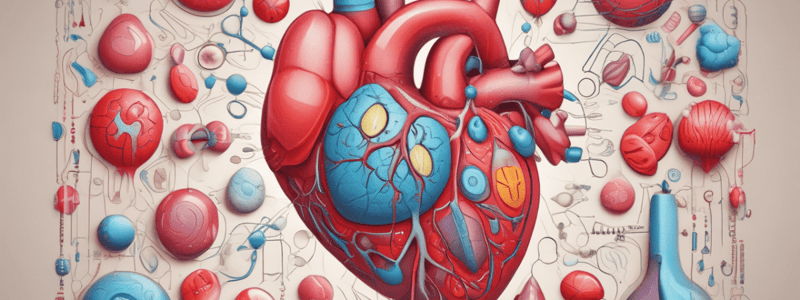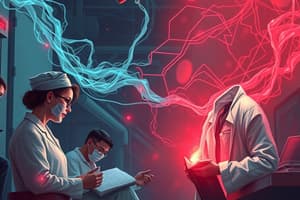Podcast
Questions and Answers
What is the primary mechanism of beta blockers that leads to bradycardia?
What is the primary mechanism of beta blockers that leads to bradycardia?
- Reducing contractility
- Decreasing GI motility
- Suppressing the AV node (correct)
- Blocking beta 2 receptors in bronchioles
Which of the following is a potential consequence of using adenosine in a patient with a history of asthma?
Which of the following is a potential consequence of using adenosine in a patient with a history of asthma?
- Increased GI motility
- Tachycardia
- Bronchospasm (correct)
- Hypertension
What is the antidote for digoxin toxicity?
What is the antidote for digoxin toxicity?
- Glucagon
- Calcium
- Adenosine
- Digibind (correct)
Which class of sodium channel blockers is associated with CNS stimulation or depression?
Which class of sodium channel blockers is associated with CNS stimulation or depression?
What is the effect of hypokalaemia on digoxin toxicity?
What is the effect of hypokalaemia on digoxin toxicity?
Which type of blockers can cause prolongation of the QT interval and increase the risk of EADs?
Which type of blockers can cause prolongation of the QT interval and increase the risk of EADs?
What is the primary mechanism of calcium channel blockers that leads to hypotension?
What is the primary mechanism of calcium channel blockers that leads to hypotension?
Which of the following is a side effect of beta blockers that can be particularly problematic in patients with COPD or asthma?
Which of the following is a side effect of beta blockers that can be particularly problematic in patients with COPD or asthma?
What is the primary mechanism of action of adenosine in the management of atrial fibrillation?
What is the primary mechanism of action of adenosine in the management of atrial fibrillation?
Which of the following is a characteristic of sodium channel blockers (class I)?
Which of the following is a characteristic of sodium channel blockers (class I)?
What is the goal of rate control in the management of atrial fibrillation?
What is the goal of rate control in the management of atrial fibrillation?
Which of the following is an indication for cardioversion in the management of atrial fibrillation?
Which of the following is an indication for cardioversion in the management of atrial fibrillation?
What is the mechanism of action of beta blockers (class II) in the management of atrial fibrillation?
What is the mechanism of action of beta blockers (class II) in the management of atrial fibrillation?
Which of the following is a characteristic of potassium channel blockers (class III)?
Which of the following is a characteristic of potassium channel blockers (class III)?
What is the primary goal of rhythm control in the management of atrial fibrillation?
What is the primary goal of rhythm control in the management of atrial fibrillation?
What is the difference between cardioversion and defibrillation?
What is the difference between cardioversion and defibrillation?
What is the role of flecainide in the management of atrial fibrillation?
What is the role of flecainide in the management of atrial fibrillation?
Which of the following is a contraindication for the use of beta blockers in the management of atrial fibrillation?
Which of the following is a contraindication for the use of beta blockers in the management of atrial fibrillation?
What is the primary mechanism of action of Atropine in treating heart block?
What is the primary mechanism of action of Atropine in treating heart block?
Which of the following Class I antiarrhythmic agents blocks sodium channels in both activated and inactivated states?
Which of the following Class I antiarrhythmic agents blocks sodium channels in both activated and inactivated states?
What is the effect of Class 1B antiarrhythmic agents on the action potential duration (APD) and effective refractory period (ERP)?
What is the effect of Class 1B antiarrhythmic agents on the action potential duration (APD) and effective refractory period (ERP)?
Which of the following is a Class IV antiarrhythmic agent?
Which of the following is a Class IV antiarrhythmic agent?
What is the primary mechanism of action of Epinephrine in treating heart block?
What is the primary mechanism of action of Epinephrine in treating heart block?
Which of the following Class I antiarrhythmic agents has a marked effect on the QRS interval on the ECG?
Which of the following Class I antiarrhythmic agents has a marked effect on the QRS interval on the ECG?
What is the Vaughan Williams classification based on?
What is the Vaughan Williams classification based on?
What is the primary mechanism of action of pacing in treating heart block?
What is the primary mechanism of action of pacing in treating heart block?
Study Notes
Adverse Drug Reactions
- Beta blockers:
- Suppress AV node, leading to bradycardia
- Reduce contractility, leading to decreased cardiac output (CO) and hypotension (especially in heart failure patients)
- Block beta 2 receptors in bronchioles, leading to bronchospasm and exacerbating COPD and asthma
- Glucagon can be given as an antidote
- Calcium channel blockers:
- Suppress AV node, leading to bradycardia
- Reduce contractility, leading to decreased CO and hypotension (especially in heart failure patients)
- Decrease GI motility, leading to constipation
- Calcium can be given as an antidote
- Adenosine:
- Causes sense of impending doom
- Leads to bronchospasms (short-lived)
- Causes chest pain
- Increases blood flow to skin capillaries, leading to flushing
- Causes arteriole vasodilation, leading to hypotension (not profound due to short half-life)
- Digoxin:
- Causes cholinergic side effects (nausea, vomiting, diarrhea)
- Inhibits sodium-potassium ATPase, leading to hyperkalemia
- Increases calcium within cells, leading to DADs and VT
- Hypokalemia can increase digoxin toxicity (K+ competes with digoxin for receptor binding)
- Digibind can be given as an antidote
- Sodium channel blockers:
- Class 1a: weak potassium channel block, prolonging ERP/APD, and increasing risk of EAD and Torsades de pointes
- Class 1b: CNS stimulation or depression
- Class 1c: pro-arrhythmic in patients with ischemic or structural heart disease
- Potassium channel blockers:
- Prolong QT interval, increasing risk of EAD and Torsades de pointes
Heart Block
- Heart block can lead to low HR, low CO, and low BP, causing hemodynamic instability
- Atropine:
- Decreases parasympathetic activity
- Blocks binding of acetylcholine to receptors in AV node
- Epinephrine:
- Increases sympathetic activity
- Pacing:
- Transcutaneous
- Transvenous
- Permanent
Antiarrhythmics
- Vaughan William classification:
- Classifies antiarrhythmics based on their ability to abolish arrhythmia by blocking specific ion currents during the action potential
- Class I: sodium channel blockers
- Class II: beta blockers
- Class III: potassium channel blockers
- Class IV: calcium channel blockers
Class I (Sodium Channel Blockers)
- Block fast, voltage-gated sodium channels responsible for phase 0 in contractile cells only
- Sub-classified into Class 1a, 1b, and 1c, based on how they block the channel
- Class 1a and 1c drugs block sodium channels in both activated and inactivated states
- Class 1b drugs block sodium channels in inactivated state
Arrhythmias - Rate Control or Rhythm Control?
- Non-pharmacological methods (carotid sinus massage, Valsalva maneuver) may terminate SVTs in stable patients
- Rate control:
- Reduces conduction via AV node
- Adenosine, beta blockers (Class II), calcium channel blockers (Class IV), and digoxin (ABCD) are used
- Suitable for SVT, atrial fibrillation, and atrial flutter
- Rhythm control:
- Reduces additional currents and restores sinus rhythm
- Sodium channel blockers (Class I), potassium channel blockers (Class III), and beta blockers are used
- Suitable for atrial fibrillation, atrial flutter, VT, and Torsades de pointes
Treatment of Specific Arrhythmias
- SVT:
- Rate control acutely with adenosine
- Prophylactic with beta blockers or calcium channel blockers
- Atrial fibrillation/flutter:
- Rate control with beta blockers, calcium channel blockers, and digoxin
- Rhythm control with sodium channel blockers and potassium channel blockers
- Risk of stroke is high; consider anticoagulants
- VT:
- Rhythm control with sodium channel blockers and potassium channel blockers
- Beta blockers to reduce sympathetic activity
- Torsades de pointes:
- Magnesium to reduce QT interval
- Class 1b
Cardioversion and Defibrillation
- If hemodynamically unstable:
- Cardioversion (electrical or chemical cardioversion) synchronizes pulses with QRS complex (mainly R wave)
- Defibrillation is an asynchronous pulse given
- Long-term treatment: radiofrequency ablation of the affected tissue
Studying That Suits You
Use AI to generate personalized quizzes and flashcards to suit your learning preferences.
Related Documents
Description
This quiz covers the adverse effects of beta blockers and calcium channel blockers, including their impact on heart rate, contractility, and airway function. Learn about the potential consequences of these medications and how to manage them.




